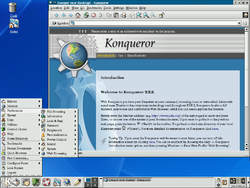K Desktop Environment 2
 |
|

K Desktop Environment 2.2.2
|
|
| Developer(s) | KDE |
|---|---|
| Initial release | 23 October 2000 |
| Stable release |
2.2.2 / 21 November 2001
|
| Development status | Superseded by K Desktop Environment 3 |
| Written in | C++ (Qt 2) |
| Operating system | Unix-like with X11 |
| Type | Desktop environment |
| Website | kde |
K Desktop Environment 2 was the second series of releases of the K Desktop Environment. There were three major releases in this series.
K Desktop Environment 2 introduced significant technological improvements compared to its predecessor.
DCOP (Desktop COmmunication Protocol), a client-to-client communications protocol intermediated by a server over the standard X11 ICE library.
KIO, an application I/O library. It is network transparent and can access HTTP, FTP, POP, IMAP, , SMB, LDAP and local files. Moreover, its design permits developers to "drop in" additional protocols, such as WebDAV, which will then automatically be available to all KDE applications. KIO can also locate handlers for specified MIME types; these handlers can then be embedded within the requesting application using the KParts technology.
KParts, a component object model, allows an application to embed another within itself. The technology handles all aspects of the embedding, such as positioning toolbars and inserting the proper menus when the embedded component is activated or deactivated. KParts can also interface with the KIO trader to locate available handlers for specific MIME types or services/protocols.
KHTML, an HTML 4.0 compliant rendering and drawing engine. It supports many Internet technologies, including JavaScript, Java, HTML 4.0, CSS 2, and SSL for secure communications. It is compatible with Netscape plugins such as Flash. KHTML also has the capacity to embed components within itself using the KParts technology.
...
Wikipedia
